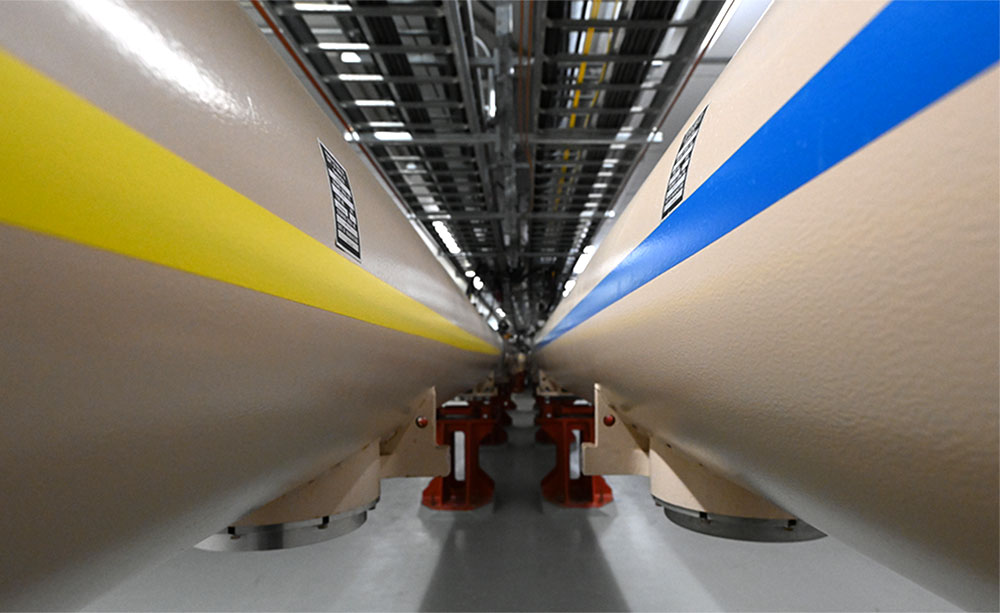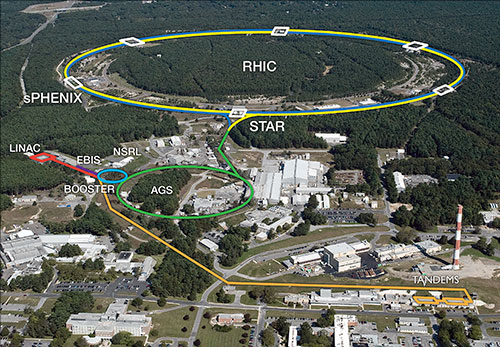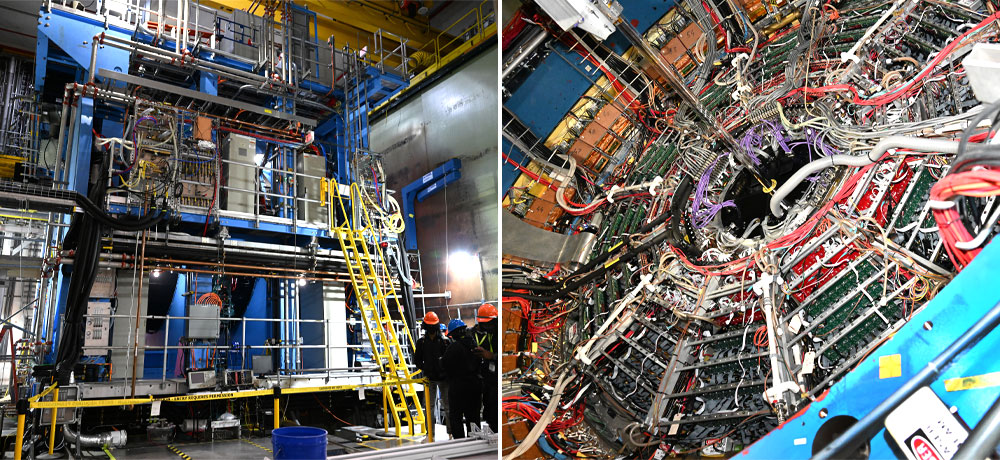Relativistic Heavy Ion Collider Begins Run 24
Highlights include proton-proton smashups, first physics data for sPHENIX, new collisions "seen" by forward detectors at STAR, and more
April 15, 2024
 enlarge
enlarge
The twin rings of the Relativistic Heavy Ion Collider (RHIC) will soon begin colliding ions. On the menu for Run 24: collisions of polarized protons followed later by gold-gold smashups. (Kevin Coughlin/Brookhaven National Laboratory)
UPTON, N.Y. — Today marks the startup of the 24th run of the Relativistic Heavy Ion Collider (RHIC), a U.S. Department of Energy (DOE) Office of Science user facility for nuclear physics research at DOE’s Brookhaven National Laboratory. Physicists at RHIC’s two house-sized particle detectors, sPHENIX and STAR, are eagerly awaiting the first collisions in Run 24 of protons speeding in opposite directions around the accelerator’s twin 2.4-mile-circumference rings.
At RHIC, the protons — positively charged building blocks of atomic nuclei — are polarized, meaning their “spins” are preferentially aligned. By analyzing how certain particles emerge from collisions relative to this spin direction, scientists can explore how a proton’s own internal building blocks — quarks and gluons — contribute to its overall spin.
 enlarge
enlarge
A chain of accelerators at Brookhaven National Laboratory brings protons or atomic nuclei up to speed and injects them into the counter-circulating "gold" and "blue" rings of the Relativistic Heavy Ion Collider (RHIC). Pairs of protons or ions collide at the center of two house-sized detectors, STAR and sPHENIX. Scientists analyze particles streaming out of collisions to learn about the building blocks of matter.
The proton-proton collisions also provide important comparison data for RHIC’s collisions of larger atomic nuclei. Collisions of nuclei such as gold, consisting of many protons and neutrons, recreate the conditions of the early universe by setting “free” the quarks and gluons that make up the protons and neutrons. Scientists use RHIC to explore detailed properties of the resulting quark-gluon plasma (QGP) and the strong force — the strongest force in nature — which holds quarks together in the matter that makes up our world today.
Collecting comparison proton-proton data in Run 24 is especially important for sPHENIX, a brand-new detector that saw its first gold-gold collisions last year. Run 24 is the second-to-last planned for RHIC before much of its infrastructure is converted into the future Electron-Ion Collider (EIC). Run 25 will be focused on collecting unprecedented amounts of gold-gold collision data.
“Run 24 is our only chance to collect proton-proton data according to the current plan,” said sPHENIX co-spokesperson Gunther Roland, a physicist at Massachusetts Institute of Technology (MIT).
Brookhaven Lab physicist Dave Morrison, the other sPHENIX co-spokesperson, added, “We need the proton-proton baseline to accurately know what’s going on in gold-gold.”
STAR has collected copious proton-proton data in many previous runs. But Run 24 will be the first using recent detector upgrades at the planned collision energy — 200 billion electron volts. These upgrades will track particles streaming out perpendicular to the direction of the colliding beams, including those very close to the collision point, as well as particles emerging far out in the “forward” direction along the beampipe.
 enlarge
enlarge
The sPHENIX and STAR detectors at the Relativistic Heavy Ion Collider (RHIC). (Kevin Coughlin/Brookhaven National Laboratory)
According to STAR co-spokespersons Lijuan Ruan, a physicist at Brookhaven, and Frank Geurts of Rice University, the new detector capabilities will allow STAR physicists to turn qualitative observations into precision conclusions about QGP properties and gain new insight into internal details of the proton’s spin.
“We know that we can expect something exciting in the forward direction,” Geurts said. “This certainly is going to be a very interesting run.”
In addition to 19 planned weeks of proton-proton collisions, there will be six more weeks in the 25-week run. A few of those weeks will be devoted to gold-gold collisions so the sPHENIX collaboration can be sure their detector is ready for next year’s intense gold-gold run. Accelerator physicists will also be continuing accelerator studies that will help inform the design of the EIC.
“We are happy to be starting up the only operating collider in the U.S. and the most versatile collider in the world,” said Michiko Minty, associate chair for accelerators and applications of the Lab’s Collider-Accelerator Department.
Read more about plans for RHIC Run 24
Brookhaven National Laboratory is supported by the Office of Science of the U.S. Department of Energy. The Office of Science is the single largest supporter of basic research in the physical sciences in the United States and is working to address some of the most pressing challenges of our time. For more information, visit science.energy.gov.
Follow @BrookhavenLab on social media. Find us on Instagram, LinkedIn, X, and Facebook.
2024-21811 | INT/EXT | Newsroom









